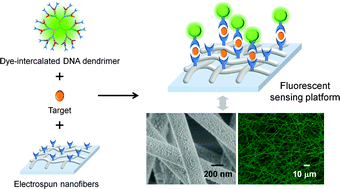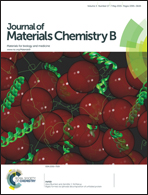Integrating dye-intercalated DNA dendrimers with electrospun nanofibers: a new fluorescent sensing platform for nucleic acids, proteins, and cells†
Abstract
We integrated for the first time a novel dye-intercalated DNA dendrimer probe (G3SG) with the electrospun nanofibers (NFs) to create an amplified fluorescent sensing platform for the detection of nucleic acids, proteins, and cancer cells. The sensing platform is constructed based on the formation of the NF-capture/target/reporter-G3SG sandwich-type nanocomplex on the NF membrane surface, leading to large fluorescence signal amplification. Taking advantage of the dual-amplification of both the strong emission intensity of G3SG and the large surface area-to-volume ratio of NFs, this platform enables highly sensitive detection of 20 pM of a β-thalassemia gene fragment. Furthermore, by easily altering the correlative capture and reporter sequences, the proposed sensing platform can also be applied to detect various targets including thrombin and HeLa cells with high sensitivity and selectivity. This work would provide a simple and versatile strategy for detecting disease-related species in biological samples.


 Please wait while we load your content...
Please wait while we load your content...